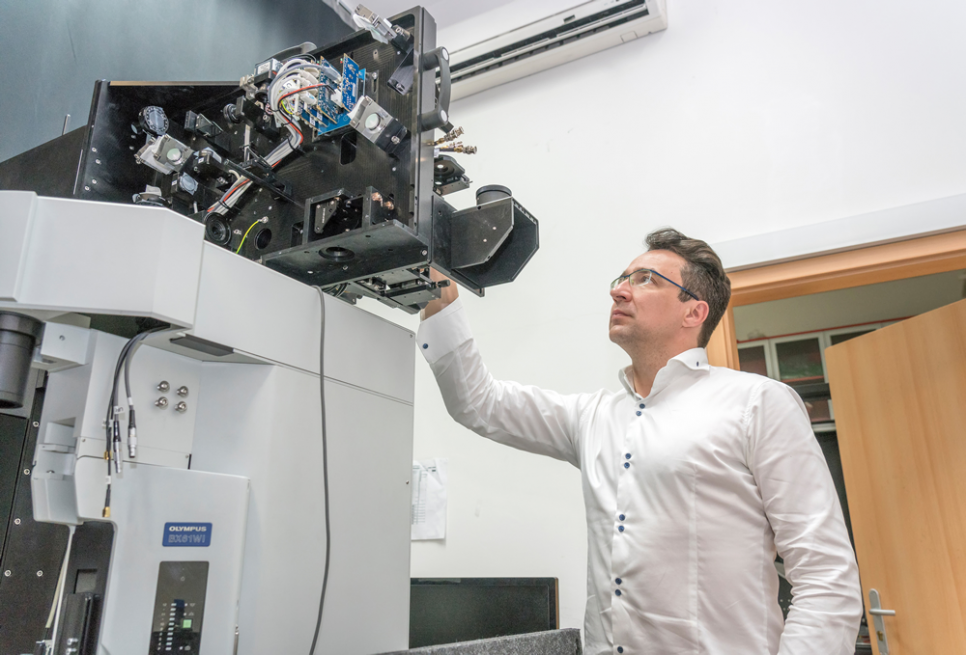
Balázs Rózsa
At the beginning of the millennium, a brand-new microscopic method began to spread in brain science. The technology of two-photon laser scanning microscopy made use of interface with optics and quantum mechanics to create high-resolution images of living brain cells that were unimaginable earlier. Brain researchers at IEM-HAS are eager to take pace with their foreign colleagues, so they also want to benefit from the opportunities offered by this new technology. But soon they had to realise a major difficulty: the price of such devices available on the market seemed not-at-all microscopic.
“At that time, the cost of such commercially available device was more than one million euros. Plus, these were suitable for performing very simple measurements only. For example, we couldn’t do targeted measurements on the length of dendrites. So there was nothing for it but to build our own microscope. As a garage company for real, we did the best we could do, even used discarded equipment”, says Femtonics founder and managing director, Balázs Rózsa as he recalls the beginnings of the story. “After immense development efforts, we eventually managed to build our first system that earned us an immediate coverage in a leading scientific journal in the world. At that time, it was a real big deal but now, thanks also to funding we are granted, our papers get regularly published in Nature periodicals. Having proven to ourselves we were capable of constructing such equipment and found that researchers are interested in it, we launched Femtonics as a spin-off. Up to this day, the company continues to reinvest practically a hundred percent of its profits into research and development.”
So Femtonics is engaged in two-photon laser scanning microscopy to be used for research or diagnostic purposes by brain researchers, clinical doctors, pharmaceutical companies and other players in neuroscience. Just the brain research sector itself employs nearly one million people worldwide while markets for surgery and diagnostics are even more extended.
Femtonics has created a multidisciplinary consortium that includes medical specialists, and mechanical, electric, optical design and software development engineers, biologists and laser physicists. One of their ambition is to develop a two-photon laser scanning microscope that works lightning fast compared to laser scanning microscopes commonly used today and a fluorescent dye that could make the activities of neurons visible. From the aspect of surgery, this will enable rapid brain functioning to be measured on cell level and on a sufficiently large area. The consortium, including also the National Institute of Clinical Neurosciences, the Department of Atomic Physics of Budapest University of Technology and Economics, Wigner Research Centre for Physics of the Hungarian Academy of Sciences and Progressio Engineering Kft. as partners, was awarded HUF 1.13 billion in funding under the funding programme “National Competitiveness and Excellence Programme” (NVKP_16) announced by the National Research, Development and Innovation Office.
“The long-term mission of our company is to benefit from the multidisciplinary knowledge available in Hungary. A huge advantage of the Hungarian mindset is its ability to comprehend a number of various disciplines at once. For us this is essential as our work equally demands the understanding of mathematics, quantum physics, biology, and information technology” says Balázs Rózsa. “We do high-speed measurements of brain functioning on microscopic scale. We set a world record with our devices being a million times faster in registering the brain functioning of living animals in laboratory. And the sufficiency of this speed is still unsure, as real time observation of neural processes may require even higher speed. But we will soon be able to satisfy this demand.”
The microscopes they built struck the scientific community as a sensation. And almost immediately the need for implementing Femtonics’ technology in medical practice as quickly as possible arose, meaning that curing patients is also directly served by their developments. The laser scanning microscopes of the company are sufficiently fast and their resolution is high enough to provide an operating surgeon with crucial information even in the course of brain surgery.
Although today’s brain imaging techniques (such as functional MRI and positron emission tomography or PET) are able to diagnose brain functioning, their resolution compared to the size of brain cells is rather poor. At best, they can interpret the activities of one cubic millimetre of brain tissue as a single pixel, although such a tissue may contain as many as one million neurons with completely different activities. In contrast, Femtonics’ microscopes allow for the individual examination of each neuron. Yet, it solves only one part of the problem as using it during operation requires not only high-resolution but speed as well. And the best way of increasing speed is – as opposed to the former toilsome and slow solutions – not to use mechanical actuation but to programme the focusing of beams with acousto-optic scanners and deflectors. They hope that soon these devices will be able to make images of 25-100 square millimetre areas of the brain in a single step that would be of great relevance also from surgical aspect.
So far, microscopes could take images of the surface of the brain only, while phenomena bearing significance from the aspect research and medicine often occur inside the brain. That means the microscope somehow needs to be driven into the brain. This is what the stereotaxic surgical robot purchased from the funding will be used for (stereotaxy is a minimally invasive form of surgical intervention using a three-dimensional coordinate system to locate small areas inside the brain). As opposed to man, this robot is able to get to the neurons’ nuclei deep inside the brain much more precisely, with an accuracy of the tenth of a millimetre. Recently, the robot was used in operation for the first time. Medical experts of the National Institute of Clinical Neurosciences were the first in Central Europe to carry out a successful robot-assisted epilepsy surgery.
“The microscope we are developing was not yet involved in this operation. The robot helped in sending the stimulation electrode that reduces epilepsy symptoms into that very neuron’s nucleus where it was supposed to go. The system calibrates the location of the target and marks the exact point where the skull needs to be drilled and assists also in sending the electrode in” continues Balázs Rózsa. “But later on, we will use the robot to send our technology deep into the brain so that we could make images of the functioning of brain cells right there. This will open up a so far unimaginable range of therapeutic opportunities and, as foreseen by us, we do not have to wait for that too long.”
As a result of the developments made under this funding a brand-new laser scanning microscope product line was created that was sold, among others, to Columbia University, one of the most renown universities in the USA, also to Germany, Switzerland and China. So, financial return is also on the horizon. In addition to export revenues, the new microscopes will bring considerable success to Hungarian science as well. Besides Femtonics’ employees, Hungarian and foreign fellow-researchers and students working for the company also play a significant role. Some of them are university students doing research for their thesis, while others are frontier scientists of the field. With students included more than a hundred people works currently for the company. At Femtonics you can see fundamental research of neurology and physics in action and also the way achievements are translated into practice: an internationally outstanding experience what attracts students from a number of universities across the country, the founder says.
“Hungary has a rich history in brain research. Relying on this past, our team has already achieved to be considered among the leading laboratories of the world but without funding through competitions we could not meet high professional standards this field of science demands. Without it we could not afford to employ half of the experts we are working with” explains Balázs Rózsa. “The success of Hungarian spin-offs in securing knowledge and keeping it in the country are crucial for the future of our nation. We are able to influence students to choose research as a career because creating value at us requires more brainwork and less of raw materials. We may even lay the foundations for a new industrial segment, considering that these developments generate complex diagnostic procedures that may bring about a revolution in brain research and brain surgery.”
The founder also added that, as an embranchment of the research carried out under the funding, another research project has been emerging the importance of which goes far beyond the role of the lightning-fast microscopic images assisting brain surgery. Driven by a bold idea, they began to search for non-invasive methods based on their existing technology to detect any diseases of the central nervous system and tumorous diseases through the skin (i.e. involving no instruments driven into the body and causing changes in it). This could lead to a breakthrough in treating tumours as well as identifying various psychiatric diseases.







